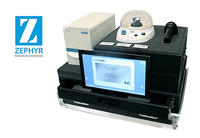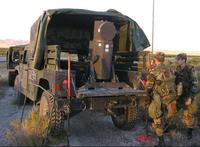-
Leidos awarded DHS Plum Island biolab contract
DHS awarded Reston, Virginia-based Leidos a prime contract to support and supplement the Science and Technology (S&T) Agricultural Scientific Program at the Plum Island Animal Disease Center (PIADC). The single-award time and materials (T&M) contract has a one-year base period of performance, four one-year options, and a total contract value of approximately $12 million if all options are exercised. Work will be performed in Orient Point, New York.
-
-
Scientists urge U.S. to do more to detect, prevent use of bioweapons
Carefully targeted biological weapons could be as dangerous as nuclear weapons, so the United States should invest more resources in developing technologies to detect them, scientists say. What is especially worrisome is that “The advent of modern molecular genetic technologies is making it increasingly feasible to engineer bioweapons,” says one expert. “It’s making people with even moderate skills able to create threats they couldn’t before.” There is another worry: “A high-tech bioweapon could cost only $1 million to build,” the expert adds. “That’s thousands of times cheaper than going nuclear. Iran’s centrifuges alone cost them billions.”
-
-
Validating air sampling techniques to fight bioterrorism
Air and surface sampling techniques currently used by the U.S. government are effective in fighting bioterrorism and potentially saving lives, a new study says. Air sampling has been readily accepted for similar uses such as measuring for particulate matter, but using it to detect bacteria in biological terrorism was a new concept instituted after the 9/11 attacks. This type of sampling is now part of a sophisticated system used by the DHS and the Department of Defense. In order for the system to work more efficiently, however, experts say that the detection cycle, which currently takes between 12-36 hours, would need to produce results in a shorter time frame.
-
-
Battelle shows smart technology for biodefense and hazard avoidance
Battelle last week announced production of the next generation chemical and biological hazard sensor system, which the company says operates at a fraction of the cost of current technologies. The technology, known as the Resource Effective BioIdentification System (REBS), is a battery-powered system capable of autonomous use with operating costs of less than $1 per day per unit (the company notes that current system costs that can range from $500 - $3,000 per day) and assay costs of $0.04 per sample (compared to current systems at over $100 per sample).
-
-
DHS cancels acquisition of BioWatch’s Generation 3 technology
Owing to concerns about BioWatcheffectiveness and high cost, DHS has canceled plans to install an automated technology meant to speed the 24-hour operations of the program, the nation’s system for detecting a biological attack.ASeptember 2012 GAO report estimated that annual costs to operate the Generation 3 technology would be “about four times more” than the existing BioWatch system.
-
-
PathSensors introduces portable pathogen identifier system

Baltimore, Maryland-based PathSensors, Inc. has introduced the portable Zephyr Pathogen Identifier system. The company says it delivers rapid, reliable detection of bacteria, virus, and toxins in powder and liquid samples in minutes. The Zephyr Identifier uses CANARY (Cellular Analysis and Notification of Antigen Risks and Yields) technology, which is licensed from the MIT-Lincoln Laboratory.
-
-
Amid controversy, Boston City council debates banning Level 4 Biolab
Boston has long been seen as “America’s Medical Capital,” but that may soon change if the city passes a measure to ban Level 4 Biolab disease research at Boston University’s National Emerging Infectious Diseases Laboratory – research which includes deadly and untreatable strains that could decimate an exposed urban population in the event of an accident or terrorist activity.
-
-
Pocket-sized anthrax detector aids global agriculture
Bacillus anthracis, the bacteria that causes anthrax, is commonly found in soils all over the world and can cause serious, and often fatal, illness in both humans and animals. The bacteria can survive in harsh conditions for decades. In humans, exposure to B. anthracis may occur through skin contact, inhalation of spores or eating contaminated meat. A credit-card-sized anthrax detection cartridge developed at Sandia National Laboratories and recently licensed to a small business makes testing safer, easier, faster, and cheaper.
-
-
Identifying the most likely non-state chem-bio threats
New research finds that Jihadists pose the most likely chem-bio threat, but other actors also featured as top threats. Jihadist actors occupied seven of the top 10 spots in a qualitative analysis; nine of the top 10 in a quantitative analysis; and half of the top 10 in an elicitation analysis.
-
-
2014 edition of updated first responder biodetection technology guide available
A 2014 update to a detailed product guide listing biodetection technologies and sampling products is now available. The updated digest, Biodetection Technologies for First Responders: 2014, provides a comprehensive compilation of commercially available detection devices and products published to help first responders when purchasing equipment and supplies needed to rapidly assess biological threats.
-
-
Cutting edge, animatronic mannequin to test CB protective suits, equipment
The U.K. Defense Science and Technology Laboratory (DSTL) has taken delivery of a new robotic mannequin which will be used to test chemical and biological (CB) protective suits and equipment for the U.K.’s Armed Forces. The “Porton Man” uses state of the art technology and is able to walk, march, run, sit, kneel and even lift its arms as if to sight a weapon just like an infantry soldier.
-
-
Synthetic biology makes bioweapons easier to make
Scientists and policy makers are no longer unconditionally promoting scientific innovation for fear that current and future biological breakthroughs may lead to dangerous applications. Traditionally, government-backed institutions and pharmaceutical firms fueled biological innovation, but today, the barriers that limited innovation to those institutions are diminishing. The low cost and significantly reduced level of necessary expertise have provided anyone interested in developing biological technology the tools to do so. Synthetic biology, the design and engineering of biological devices and systems, has given terrorists the capability to launch attacks using synthetic organisms without detection.
-
-
Compact UV laser for biological, chemical detection

In addition to detecting chemical and biological agents in the field — or at home to protect against mass terror attacks — UV lasers have many other uses. The new class of UV lasers envisioned by DARPA’s Laser UV Sources for Tactical Efficient Raman (LUSTER) program is expected to be of use for a broad range of applications such as point-of-need medical diagnostics, advanced manufacturing, and compact atomic clocks.
-
-
Faster anthrax detection could speed bioterror response
The fall 2011 anthrax attacks cost $3.2 million in cleanup and decontamination. At the time, no testing system was in place that officials could use to screen the letters. Currently, first responders have tests that can provide a screen for dangerous materials in about 24-48 hours. Now, researchers have developed a new method for anthrax detection that can identify anthrax in only a few hours.
-
-
Gaining better understanding of tularemia, aka “rabbit fever”
Tularemia, aka “rabbit fever,” is endemic in the northeastern United States, and is considered to be a significant risk to biosecurity — much like anthrax or smallpox — because it has already been weaponized in various regions of the world. Despite its importance for both public health and biodefense, F. tularensis pathogenesis is not entirely understood, nor is it fully understood how the organism persists in the environment.
-
- All
- Regional
- Water
- Biometrics
- Borders/Immig
- Business
- Cybersecurity
- Detection
- Disasters
- Government
- Infrastructure
- International
- Public health
- Public Safety
- Communication interoperabillity
- Emergency services
- Emergency medical services
- Fire
- First response
- IEDs
- Law Enforcement
- Law Enforcement Technology
- Military technology
- Nonlethal weapons
- Nuclear weapons
- Personal protection equipment
- Police
- Notification /alert systems
- Situational awareness
- Weapons systems
- Sci-Tech
- Sector Reports
- Surveillance
- Transportation
Advertising & Marketing: advertise@newswirepubs.com
Editorial: editor@newswirepubs.com
General: info@newswirepubs.com
2010-2011 © News Wire Publications, LLC News Wire Publications, LLC
220 Old Country Road | Suite 200 | Mineola | New York | 11501
Permissions and Policies
Editorial: editor@newswirepubs.com
General: info@newswirepubs.com
2010-2011 © News Wire Publications, LLC News Wire Publications, LLC
220 Old Country Road | Suite 200 | Mineola | New York | 11501
Permissions and Policies
